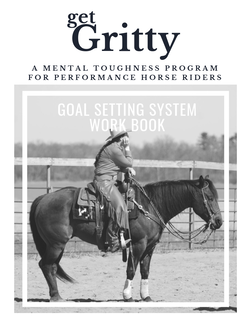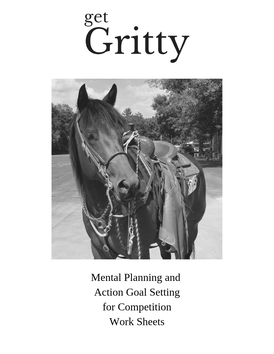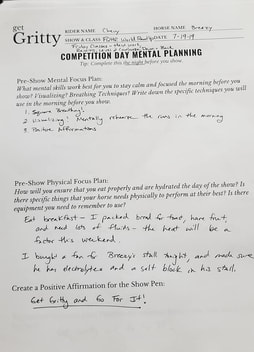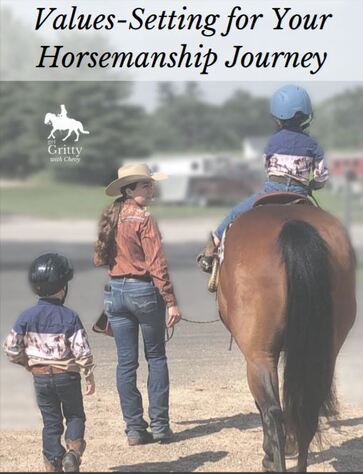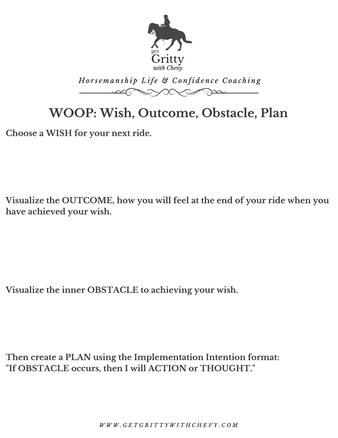Video Lessons for the Goal Setting System:
Download & Print the Work Book:
|
Click the image to download the work book. I strongly recommend that you print it out and follow along with the exercises!
| |||||||
Additional Goal Setting Materials:
Mental Planning and Action Goals for Competition Work Sheets
|
Click below to download the blank worksheets for you to use with your horse!
|
Click below to view Chevy's filled out worksheets from the FQHR World Round Up!
| ||||||||||||
Goal Setting Tip: Have a visual reminder of your goals
Beyond Goal Setting Online Workshop
In this Beyond Goal Setting Online Workshop, we will go over three exercises to help you clarify what you want for your horsemanship journey.
Exercise 1: Value Setting
Exercise 2: My Average, Everyday Perfect Ride
Exercise 3: WOOP Goal Setting Framework
Exercise 1: Value Setting
Exercise 2: My Average, Everyday Perfect Ride
Exercise 3: WOOP Goal Setting Framework
Exercise 1: Value-Setting
Use Your Values to Set Your Goals
It's that time of year again, when we typically start thinking about New Year's Resolutions and Goals.
Let's get real for a minute. COVID-19 has wrecked traditional goal setting. It is hard to stay motivated towards goals when there is so much stress and uncertainty right now.
However, I still believe there is value in goal setting, and despite the COVID-related craziness, I still encourage you to set goals. Let's just set our goals a little differently this year.
Using your values to drive and set your goals.
What is the difference between values and goals?
Values are a like a guide, a general direction that we move towards. They are an on-going process.
Goals are attainable, something that we can cross off a list.
Both values and goals are very important. When you use your values to set your goals, you will enjoy the journey more and you will get more fulfillment and happiness out of your horsemanship, and your life. And, when you use your values to set your goals, they will be more resilient to unexpected obstacles, like COVID cancellations, your horse coming up lame the day before a big show or trail ride, or changes in your life that you cannot control.
For this Coaching Exercise, get out a pen and paper and download the Values Setting Workbook.
It's that time of year again, when we typically start thinking about New Year's Resolutions and Goals.
Let's get real for a minute. COVID-19 has wrecked traditional goal setting. It is hard to stay motivated towards goals when there is so much stress and uncertainty right now.
However, I still believe there is value in goal setting, and despite the COVID-related craziness, I still encourage you to set goals. Let's just set our goals a little differently this year.
Using your values to drive and set your goals.
What is the difference between values and goals?
Values are a like a guide, a general direction that we move towards. They are an on-going process.
Goals are attainable, something that we can cross off a list.
Both values and goals are very important. When you use your values to set your goals, you will enjoy the journey more and you will get more fulfillment and happiness out of your horsemanship, and your life. And, when you use your values to set your goals, they will be more resilient to unexpected obstacles, like COVID cancellations, your horse coming up lame the day before a big show or trail ride, or changes in your life that you cannot control.
For this Coaching Exercise, get out a pen and paper and download the Values Setting Workbook.
| |||||||
To shift your mindset from Goals Focused to Values Focused, we will begin by Identifying Your Values & Horsemanship Priorities.
Ask Yourself:
What kind of rider do you want to be?
How would you want your horse to describe you?
How do you want other horsemen/women to describe you?
What do you want to improve upon in your horsemanship?
Then, Review the list of Values (in the workbook).
Which Values are most important to you?
How can you plan your horsemanship journey to respect your values?
Take a closer look at your list of values.
Are they aligned with your horsemanship goals?
Think about the actions that you will need to take to achieve your goals.
Are these actions aligned with your values?
In achieving your goals, will you become someone that exemplifies the values that are important to you?
If yes, great! Carry on!
However, if when you review the actions that you will need to take to achieve your goals you start to get that icky feeling inside...then it is a sign that you might need to re-adjust your goals. That's OK too! We all learn and grow and change throughout our journey-both in life and horsemanship! Celebrate what you have learned, and set new goals that are aligned with your values, and you will be happier along the way.
Ask Yourself:
What kind of rider do you want to be?
How would you want your horse to describe you?
How do you want other horsemen/women to describe you?
What do you want to improve upon in your horsemanship?
Then, Review the list of Values (in the workbook).
Which Values are most important to you?
How can you plan your horsemanship journey to respect your values?
Take a closer look at your list of values.
Are they aligned with your horsemanship goals?
Think about the actions that you will need to take to achieve your goals.
Are these actions aligned with your values?
In achieving your goals, will you become someone that exemplifies the values that are important to you?
If yes, great! Carry on!
However, if when you review the actions that you will need to take to achieve your goals you start to get that icky feeling inside...then it is a sign that you might need to re-adjust your goals. That's OK too! We all learn and grow and change throughout our journey-both in life and horsemanship! Celebrate what you have learned, and set new goals that are aligned with your values, and you will be happier along the way.
Exercise 2: Your Average, Everyday Perfect Ride
How we spend our days is how we spend our lives.
What would an average, everyday perfect ride be like for you and your horse?
Seriously, get out your journal today and write down what a perfect everyday ride would be like.
By taking the time to visualize it and write it down it you will give your mind a clearer goal of what you want to have happen. And when you have a clear and defined goal, it is much more likely to happen.
Here's my Average, Everyday Perfect Ride:
My horse walks up to me in the pasture. I halter him, and we walk to the barn. I brush and tack him up, taking time to enjoy that horse smell and the feel of his coat under my hands. He lowers his head to be bridled, then we walk to the arena. I step into the saddle, and he waits for me. We walk a few circles, then trot. He bends softly to the reins. We leg yield a few times each way to make sure he is listening to my leg, then lope off. A a few circles each way, I bring him back to a walk. I ride over and open the gate, then ride out to the pasture to check cows. We long-trot across the field, enjoying being outside with the wind in our hair. At the creek I stop and give my horse a minute to drink. Then it is back to work, riding through the herd at a walk, checking that all are accounted for and healthy. Then it is time to head back home. We cross the creek, then lope across the field. I savor the feeling of loping, my horse and I moving together in harmony, his stride covering ground, hearing his hoofbeats. When we get to the field road I sit back, and my horse slows to a walk. We make a detour, walking down our long driveway to get the mail, this works great as our cool-down. When we get back to the barn I step down and take off the bridle, slip on his halter, and tie him up. As I unsaddle him, I smile. This was a great ride!
What would an average, everyday perfect ride be like for you and your horse?
Seriously, get out your journal today and write down what a perfect everyday ride would be like.
By taking the time to visualize it and write it down it you will give your mind a clearer goal of what you want to have happen. And when you have a clear and defined goal, it is much more likely to happen.
Here's my Average, Everyday Perfect Ride:
My horse walks up to me in the pasture. I halter him, and we walk to the barn. I brush and tack him up, taking time to enjoy that horse smell and the feel of his coat under my hands. He lowers his head to be bridled, then we walk to the arena. I step into the saddle, and he waits for me. We walk a few circles, then trot. He bends softly to the reins. We leg yield a few times each way to make sure he is listening to my leg, then lope off. A a few circles each way, I bring him back to a walk. I ride over and open the gate, then ride out to the pasture to check cows. We long-trot across the field, enjoying being outside with the wind in our hair. At the creek I stop and give my horse a minute to drink. Then it is back to work, riding through the herd at a walk, checking that all are accounted for and healthy. Then it is time to head back home. We cross the creek, then lope across the field. I savor the feeling of loping, my horse and I moving together in harmony, his stride covering ground, hearing his hoofbeats. When we get to the field road I sit back, and my horse slows to a walk. We make a detour, walking down our long driveway to get the mail, this works great as our cool-down. When we get back to the barn I step down and take off the bridle, slip on his halter, and tie him up. As I unsaddle him, I smile. This was a great ride!
Exercise 3: WOOP Goal Setting Framework
If we only thought about the positive, we wouldn’t achieve anything. If we didn’t think or feel any negative thoughts, we wouldn’t have any reason or motivation to change. Yet if we only focus on the negative, we wouldn't try to achieve our goals either.
In her book “Rethinking Positive Thinking” researcher Gabriele Oettingen explains that when you balance positive thinking about a desired outcome with a realistic look at the challenges and obstacles that might arise, you are much more likely to achieve your goals. Gabriele balanced this by creating her goal setting framework called WOOP. The steps to WOOP are: Wish, Outcome, Obstacle, and Plan. WOOP is a very easy mental strategy to practice.
First, watch the WOOP video below.
Then, print out the WOOP Workbook. Complete the WOOP process, and take it to the barn with you and review it before you ride!
Let's Get Ready to WOOP!
In her book “Rethinking Positive Thinking” researcher Gabriele Oettingen explains that when you balance positive thinking about a desired outcome with a realistic look at the challenges and obstacles that might arise, you are much more likely to achieve your goals. Gabriele balanced this by creating her goal setting framework called WOOP. The steps to WOOP are: Wish, Outcome, Obstacle, and Plan. WOOP is a very easy mental strategy to practice.
First, watch the WOOP video below.
Then, print out the WOOP Workbook. Complete the WOOP process, and take it to the barn with you and review it before you ride!
Let's Get Ready to WOOP!
Download the WOOP Worksheet by clicking the Download File link below.
| |||||||
